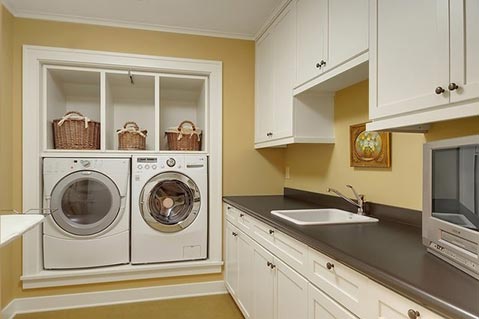House Hunter: The Staging Strategy

Somewhere along the line, I’ve heard rules for house hunters whispered to me. For instance, you’re supposed to sound savvy, as if you know the pros and cons of, say, 240-volt service versus 120. And you’re not supposed to gush about any house you like. Instead, you’re supposed to say, “Hmm, roof looks dicey.”
So when we go house hunting, we try to sound all Curb Appeal but unfortunately tend to come across more Curb Your Enthusiasm. For example, the other day in our ongoing quest, we visited a nice place in San Roque, but something didn’t click. So Connie said, “Just lie on the bed for a second, and let’s imagine we live here.” We did, for exactly one second. Then there was a splintering sound, and the bed crashed to the floor. Turns out it was a staged bed, propped up on little plastic garbage bins. Oops.
“They’re called risers,” said Tamara Ruccione of Santa Barbara Staging Solutions after enjoying a hearty laugh. “You’re not the first to do that.” It wasn’t her bed, but she said stagers have to do things like that because of the daunting task of providing furnishings for dozens of homes at once. “Imagine if you’re staging 20 or 30 houses. That would be 60 or 70 beds. You’d need a warehouse just for that.”
In fact, Ruccione does have a warehouse or two, necessities for those in the staging game. In them are the many roomfuls of furnishings to make recently emptied homes looked lived-in again for the purpose of selling. What’s more, the stock has to be constantly updated to match trends.
All of this makes it a “very expensive” business to run, Ruccione said, listing things I’d never thought of, such as two moving crews, several assistants, seamstresses, art, accent pillows, those warehouses, etc. Most businesses buy furnishings, and they’re good for years. Not so for stagers. “In this business, you’re buying every week,” she said.
Ruccione got started in the business by struggling to sell her own empty house. Someone told her the emptiness would cost her many thousands of dollars, so she went to the expense of buying furniture and did all the staging staples (cleaned house, lit the fireplace, baked cookies, etc.) and sold the place in one weekend.
She was hooked. Using those first furnishings, she started staging for hire, adding more décor along the way and building a business. People sometimes ask for advice on getting into the field. “It’s a wonderful career,” she said. “But it takes a lot of sacrifice and time and money and years to make it happen.”
The biggest change of late is the public’s growing understanding of the need for good staging, Ruccione said. Owners are already spending a lot of money fixing cracks, painting, and what have you to get houses ready for sale. Persuading them to spend more on furnishings used to be difficult. No more. Now, thanks to HGTV and such, owners are completely onboard. And homes in Santa Barbara are selling fast. When she first started eight years ago, houses sometimes languished on the market for as much as a year. “Now we barely get installed, and they’re in escrow,” she said.
As for crashing beds, Ruccione has a solution. Instead of real mattresses, she sometimes uses the inflatable version. Yes, the unsuspecting like us might send them to the ground, but at least they would go quietly.



